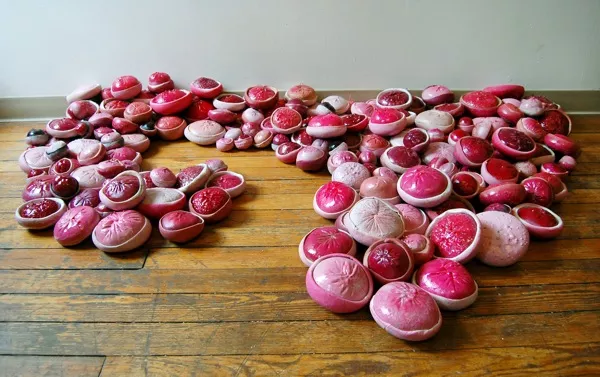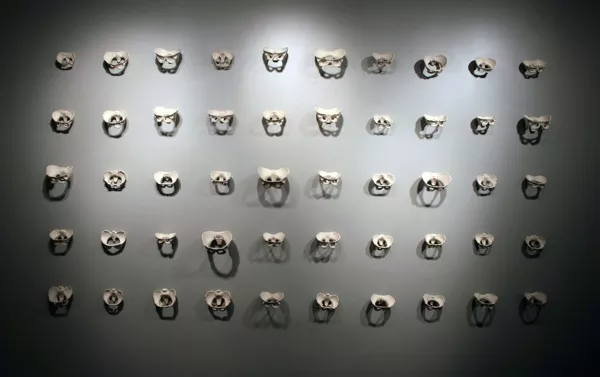
- Photo courtesy of McColl Center for Visual Art
- "Corpuscles" by Carrie Becker, part of the Elements exhibit
By Barbara Schreiber
Incorporating recycled materials, installations large and small, and wearables that challenge the idea of wearability, several current exhibitions pretty much run the gamut of three dimensional art.
In Elements at McColl Center for Visual Art, Michael Gayk and Carrie Becker deal with the organic and the cellular. Although Gayk’s work could accurately be called jewelry and Becker’s soft sculpture, these innocuous labels don’t begin to describe the bold content.
Gayk combines 3-D printing and other current technology with traditional craft. He's at his best here in a sequence of bracelets that, viewed from left to right on the gallery wall, mutate from sleek design to something you might see under an electron microscope, to pieces that look like sentient beings capable of inflicting harm. Even though produced over a period of several years, these controlled works have a hyper-focused consistency.
Carrie Becker’s sculptures and installations — made variously of cheesecloth, foam, nylon, plastic, plexi, tissues and wire — often seem to grow on walls or spill onto the floor. My favorite here is “Corpuscles,” which consists of individual pink cells, perhaps 6”-12” each, and made from plastic-coated nylon. Nestled in a corner of the immaculate gallery, they are both puzzling and inviting. Becker has also included some large-scale photos documenting installations in abandoned spaces; in “Corpuscular Infiltration,” pink cells pour from a gaping hole in a sheetrock wall. Taken together, “Corpuscles” and “Corpuscular Infiltration” are insightful examples of the importance of scale and context. Employing the same cell forms, they achieve completely different ends: Both are mysterious, but one is alluring and the other threatening.
(Elements, through Jan. 2, McColl Center for Visual Art. Thursday-Friday 2:00-7:00 p.m., Saturday 11:00 a.m.-6:00 p.m. 704-332-5535. mccollcenter.org.)

- Photo courtesy of the artist
- "Pelvii" by Erika Diamond, part of the Enduring Impermanence exhibit
Erika Diamond’s Enduring Impermanence at Central Piedmont Community College comprises several distinct bodies of work including costumes, wall-mounted pieces and a presentation made from manipulated 35mm slides.
The exhibition title refers to both Diamond’s use of ephemera to make durable objects and her yearning to understand the cycle of life and passage of time. Although refined and elegant, much of her work incorporates plastic bottles, chicken wire, pop tops, netting, onion skins and other discards. Her painstakingly constructed costumes, which have been seen onstage at North Carolina Dance Theatre and on fashion runways, shimmer with both high craft and humor. A wall of small pelvises made from porcelain and rubbed with palm frond ash are fraught with meaning, evoking numerous, sometimes conflicting associations of frailty, power and religiosity.
(Enduring Impermanence, through Nov. 7, Ross Gallery/Central Piedmont Community College. Monday-Thursday 10:00 a.m.-2:00 p.m. 704-330-6211.http://arts.cpcc.edu/art-gallery.)
I’m usually reluctant to scrutinize work involving students since they’re still working out kinks, but Rhizome, a large installation in a vacant church on Plaza Midwood’s Central Avenue, is a project worthy of attention. Under the leadership of faculty advisor Jennifer Shields, UNC Charlotte architecture students Antonio Martinez, Logan Chambers, Cherish Rosas, Will Allen, John Winstead and Sean Wilson collaborated with Boston artist Candice Ivy to interpret her drawings as architectural forms. Their intention was, in part, to create a metaphor for a community’s relationship to a building that now has an uncertain future.
A site-specific installation, Rhizome — with its light projections and looping, contorted wire-and-fabric tubes that infiltrate the sanctuary — looks as if it might be even better suited to an industrial space. (Although when viewed from the altar, the installation gains considerable power.) In its capacity to animate an empty interior and encourage viewers — whether neighbors, the creative community or the larger public — to linger and think, Rhizome definitely merits a visit. I hope it inspires similar large-scale projects — endeavors other cities enjoy but we simply don’t see enough of here.
(Rhizome, through Sept. 30, 1201 Central Ave. Saturday-Sunday, 2:00-6:00 p.m. fluxwurx.com/installation.)
